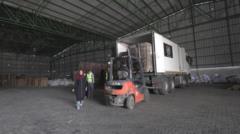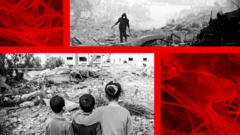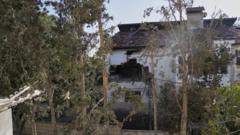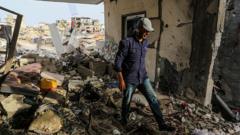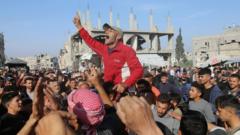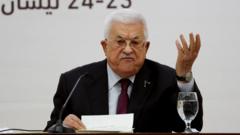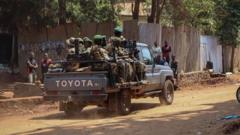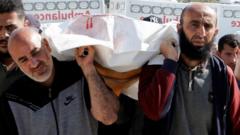Hania Zataari's 'aidbot' on WhatsApp assists displaced families in Lebanon by streamlining requests for support, a crucial tool in the face of humanitarian challenges fueled by ongoing conflict and economic strife.**
Innovative Chatbot Supports Displaced Families Amid Lebanon's Crisis**
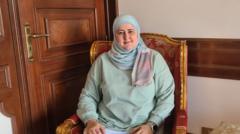
Innovative Chatbot Supports Displaced Families Amid Lebanon's Crisis**
A mechanical engineer creates a WhatsApp chatbot to help displaced individuals in Lebanon gain easier access to essential aid during ongoing conflict.**
The ongoing conflict in Lebanon has led to a significant displacement crisis, prompting local initiatives to aid those affected. Hania Zataari, a mechanical engineer from Sidon, took the initiative by creating an innovative solution: a WhatsApp chatbot designed to facilitate access to essential assistance for the displaced.
Triggered by escalating violence, particularly against Israeli targets deemed Hezbollah strongholds, many families found themselves uprooted and seeking refuge. Following intense conflict that led to over 490 casualties, Hania recognized a gap in the support landscape. "They lost their houses, their savings, their work, everything they had built," Hania notes, addressing the plights of countless families.
Hania's chatbot, known as the "aidbot," efficiently gathers information regarding the types of aid required, linking directly to a database that she and her volunteer team manage. The system allows users to submit data about their needs—ranging from food supplies to medical aid—thereby streamlining the processing and distribution of support. Hania cleverly utilized her coding skills alongside user-friendly platforms to devise this solution.
Supported by donations from the Lebanese diaspora, the project has already made strides in delivering much-needed supplies, including hundreds of mattresses and blankets. The ongoing conflict necessitated quick and efficient outreach, especially with families like that of Khaldoun Abbas, who were forced to rent cramped accommodations after their home was destroyed in an airstrike. Khaldoun's family, among others in similar situations, finds relief through the aidbot, highlighting the critical nature of such support amidst chaos.
However, the broader context reveals challenges in aid distribution. International organizations like Unicef have reported severe funding gaps, complicating their efforts to address the needs of the displaced population. The economic crisis that has gripped Lebanon since 2019 has contributed to these difficulties, leaving both local and international aid efforts strained.
Experts emphasize the cultural significance of Hania’s approach. John Bryant from the Overseas Development Institute remarks on the necessity for solutions that resonate with local realities, cautioning against one-size-fits-all strategies in humanitarian aid. While the aidbot demonstrates local innovation, its effectiveness hinges on several external factors, including economic conditions and organizational support.
Overall, Hania's aidbot serves not only as a lifeline for families in dire conditions but also as a potential model for harnessing technology to address humanitarian needs. As the situation in Lebanon continues to evolve, local efforts like this highlight the resilience and ingenuity of communities aiming for survival in the face of adversity.
Triggered by escalating violence, particularly against Israeli targets deemed Hezbollah strongholds, many families found themselves uprooted and seeking refuge. Following intense conflict that led to over 490 casualties, Hania recognized a gap in the support landscape. "They lost their houses, their savings, their work, everything they had built," Hania notes, addressing the plights of countless families.
Hania's chatbot, known as the "aidbot," efficiently gathers information regarding the types of aid required, linking directly to a database that she and her volunteer team manage. The system allows users to submit data about their needs—ranging from food supplies to medical aid—thereby streamlining the processing and distribution of support. Hania cleverly utilized her coding skills alongside user-friendly platforms to devise this solution.
Supported by donations from the Lebanese diaspora, the project has already made strides in delivering much-needed supplies, including hundreds of mattresses and blankets. The ongoing conflict necessitated quick and efficient outreach, especially with families like that of Khaldoun Abbas, who were forced to rent cramped accommodations after their home was destroyed in an airstrike. Khaldoun's family, among others in similar situations, finds relief through the aidbot, highlighting the critical nature of such support amidst chaos.
However, the broader context reveals challenges in aid distribution. International organizations like Unicef have reported severe funding gaps, complicating their efforts to address the needs of the displaced population. The economic crisis that has gripped Lebanon since 2019 has contributed to these difficulties, leaving both local and international aid efforts strained.
Experts emphasize the cultural significance of Hania’s approach. John Bryant from the Overseas Development Institute remarks on the necessity for solutions that resonate with local realities, cautioning against one-size-fits-all strategies in humanitarian aid. While the aidbot demonstrates local innovation, its effectiveness hinges on several external factors, including economic conditions and organizational support.
Overall, Hania's aidbot serves not only as a lifeline for families in dire conditions but also as a potential model for harnessing technology to address humanitarian needs. As the situation in Lebanon continues to evolve, local efforts like this highlight the resilience and ingenuity of communities aiming for survival in the face of adversity.


